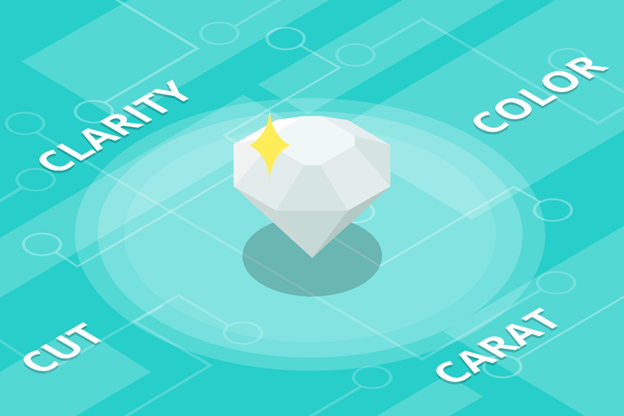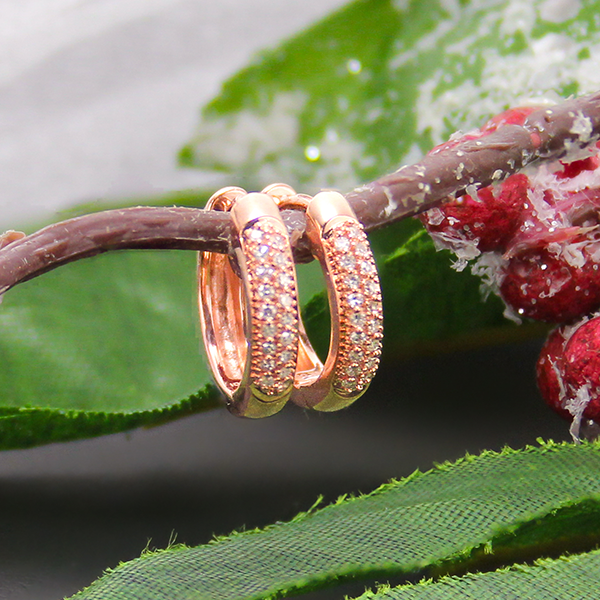Diamonds are as complex and intricate as our relationships. Why not understand the inner working of these ornate diamonds just like you seek to better understand your significant other? By grasping the 4C’s (Cut, Color, Clarity, and Carat) you will be able to understand the complexities of diamonds in a way that is straightforward and simple.
What are the 4C’s
In short, the 4C’s is an acronym that helps diamond companies educate their customers on different diamond grades. By simplifying the diamond into 4 parts it makes conceptualizing the different parts of the diamond easier. Below is a simplified explanation of the 4Cs.
Cut quality: The diamond’s cut is more than just the shape of the stone. It's also the overall light balance throughout the diamond. Essentially how well light bounces and refract across the facets.
Color: The amount of yellowing the diamond has or lacks.
Clarity: The number of inclusions and blemishes that plague the diamond
Carat weight: The measurement of how much the diamond weighs

Diamond Cut
Maybe the most important aspect of a diamond is its Cut. Though, as mentioned in our summary, a diamond’s cut does not exclusively determine its shape. A diamond cut also represents how well light is refracted across the diamond and how that affects its overall glamour. Essentially, a diamond with a perfect cut would appear brilliant and lively while a diamond with a low-quality cut might appear baron and lifeless.
Additionally, a diamond’s cut is all about getting the right proportion and angles. Therefore, diamond-cutting experts are aware of the exact right angles and use them to present the diamond in its ideal state. If there is even a slight inconsistency in the diamond's proportions it can result in less light reflecting out of the top of the diamond and toward the viewer. Thus, a well-cut diamond will allow for the maximum amount of light to enter the diamond and bounce back at the top of the diamond and into the viewer's eye. This will result in a gemstone that appears more glamourous, more brilliant, and of course more expensive.
A diamond's brilliance, fire, and Scintillation
All diamonds exhibit three visual attributes: Brilliance, Fire, and Scintillation. Here is how each of these properties is affected by a diamond’s cut
Brilliance: Brilliance is how much each individual facet of the diamond reflects white light back to the viewer. Because of this, most of the allure of a diamond lies in its brilliance. When most people think of a gorgeous diamond, they envision a shiny, reflective, and entrancing gemstone. We have the stones brilliance to thank for these attributes.
- Physical and Virtual facets:
The more physical facets a diamond cut has the more brilliant the diamond will appear. For context, a physical facet is a real and true facet that causes a reflection. Thus, multiple physical facets can create an allusion of virtual facets to enhance the appeal of the diamond. Thus, the more physical facets there are the more they can interact with each other and bounce each other's light, which will result in the appearance of more facets than there actually are. This is what we call virtual facets and can lead to a drastically increased brilliance.
Fire: A diamond's fire is actually something we call a diamond's dispersion grade, or how well the diamond separates white light into the visible light spectrum (a rainbow). Diamonds are great at making white light into different colors like a prism. Therefore, a good-quality diamond should show multiple dazzling colors deep in its core. The cleaner and more vibrant the hues the more fire the diamond has. As a result, a well-cut diamond with good dispersion results in a light show experience like no other.
Scintillation: What is this word and how does it pertain to diamond cuts? Well, Scintillation is jargon for what people commonly refer to as the diamond’s “sparkle”. Essentially scintillation is when you rotate the diamond and watch as its white light and multicolored lights move and dance around the diamond.
Diamond Color
Against popular belief, diamonds are not completely clear. Diamonds have imperfections and flaws that give diamonds their slight coloration. Since diamonds are naturally grown they gain these imperfections from the earth when they are forming and building up color from debris. For example, excess nitrogen in the diamond's formation can result in the yellowing of the diamond.
Naturally, people tend to desire diamonds that are clearer or plagued with less color. Thus Jewelers use the amount of coloring of the diamond to determine its rarity and its price. They grade these Diamonds on a scale from D-Z. ( “D”, completely colorless, to “Z”, yellow with slight browning). For example, a diamond with the grading of D has practically zero coloration and looks icy clear, these diamonds are extremely rare and thus sell at higher prices.
Diamond raters don't just simply look at the diamonds, they also inspect the yellowing of your diamond in a predetermined system. Your diamond is looked at in a three-part system: its hue, tone, and saturation.
- Hue: The diamond's hue is its actual color, i.e. blue, yellow, pink.
- Tone: The diamond's tone is the amount of darkness in the diamond. Some people also call it the shade of the diamond.
- Saturation: the intensity of the color or how prominent and vibrant it is.
Fun fact - the reason the scale grades from D-Z instead of A-Z is because the Gemological Institute of America (GIA) wanted to “start fresh” and create a scale that was different and more accurate than the previous system. The older system had an A, B, and C that was so minute in their differences that the results became false and miscalculated. So, they opted for starting at D to break away from past associations. Since then, starting at D has caught on as a standard.
Diamond Clarity
A Diamond's clarity is the number of inclusions or flaws that the diamond has. The imperfections usually take the form of blemishes that are practically invisible to see unless seen under a microscope. However, some poorly graded diamonds can have blemishes visible to the naked eye.
Remember, no diamond is perfect, each and every natural stone was created by mother nature herself, and like all things even she is flawed. In a similar light, that means that your diamond's clarity can never be a hundred percent perfect. Gemologists will look at your diamond under a 10x microscope and pick out anything they find. The diamonds with the least number of inclusions will be graded higher and thus priced higher. In the rare case that a diamond has almost zero blemished that diamond would be classified as a Flawless Diamond and labeled with the symbol FL. These FL diamonds are extremely rare and go for the highest market prices. The clarity grades range from I1 (included) - to FL.
How is your diamond’s clarity graded
Assessing the clarity of the diamond boils down to the general quantity of the inclusions present in your diamond as well as their size and volume. The positioning of the blemishes also factors into its rating as a poorly placed blemish could be potentially distracting.
Diamond Clarity Grades:
|
Rating |
What they stand for |
What do they mean |
|
FL |
Flawless |
This diamond has no inclusions. You are a very lucky lady |
|
FI |
Internally Flawless |
The diamond interior is flawless. |
|
VVS1 and VVS2 |
Very, Very Slightly Included |
Have barely any inclusions. Very difficult even for an expert diamond grader to find under a microscope. |
|
VS1 and VS2 |
Very Slightly Included |
With experience you can see the blemishes under a 10x microscope |
|
SI1 and SI2 |
Slightly Included |
Blemishes can be found when looking under a 10x microscope |
|
I1, I2, I3 |
Included |
Blemishes are obviously present when looking under a 10x microscope |
Don't fall for the trap that you need to get the best clarity diamond!
Against popular belief a diamond's clarity does not correlate to the diamond's overall brilliance and sparkle, a Diamond cut is responsible for that part of the diamond's allure. Therefore, if you feel the urge to get the best FL diamond that you can find maybe try and put your money towards getting a better cut diamond instead. Think of it this way, you will most likely never see any of the inclusions in your SI-graded diamond because you won't be looking at the diamond under a microscope on a daily basis. The difference between clarity grades is mostly a mental thing, piece of mind that your diamond is probably better than some others, but unless you have a microscope you can’t tell.
Diamond Carat
A diamond’s carat is the special measurement that we use to weigh a diamond.
Against popular belief, a diamond with a higher carat weight does not automatically mean that it's larger. A diamond's carat weight can change based on a few factors, such as density, shape, and of course size. Essentially, a large stone does not mean it has a super high carat weight, some stones might be deceiving and weigh less than they look.
What is Total Carat Weight (TCW)
Total Carat Weight (TCW) is the measurement used to collect the total carat weight of each stone on a single piece of jewelry. This tends to be a higher number the more diamonds you have on your ring. When buying a ring with multiple diamonds this is the measurement that will be used to represent the carat of the entire ring. Be warned that this number is just a sum and won't tell you how many diamonds are on the piece.
How is carat weight measured?
A one carat diamond weighs about 0.2 grams or 200 mg. This is very light and roughly about 1/10th of a paperclip or the weight of an average raindrop. This measurement is standard everywhere across all countries to maintain consistency.
Graders/weighers also give the diamonds a point value to represent their carat weight. The points are given in intervals of 10. With a 0.1 equaling 10 points each.
- 50 points = 0.5 carats
- 100 points = 1 carats
- 200 pints = 2 carats
- 300 points = 3 carats
- Etc
What carat diamond should you buy?
Same with diamond “clarity”, the “cut” and “color” of the diamond are going to be more important when it comes to the brilliance and beauty of a diamond. However, if you are looking to go for a larger actual size, and not apparent size, going for a higher carat diamond will do the trick. A good trick if you are on a budget is to try for a lower carat weight between 0.5 and 1.5. Then you could allocate most of your budget towards a better quality “cut” to make the diamond appear larger and more brilliant. It all really depends on the diamond's intended purpose. So, some questions to ask yourself are: Is it an engagement ring for a loved one who loves big and beautiful? Or is it for a wedding ring for a girl who likes the small things in life with a little flare? Ultimately, it's going to be up to you to decide what carat to get, but no matter what you choose it's still a rare and precious stone.
Fun fact: The term carat in “carat weight” originates far back in history and has nothing to do with a cute bunnies treat. Carratus which is Latin for the Carab Seed was used in ancient worlds for measuring objects of small weight. The word Carat is a derivation of the original world Carratus and not the Carrot.




